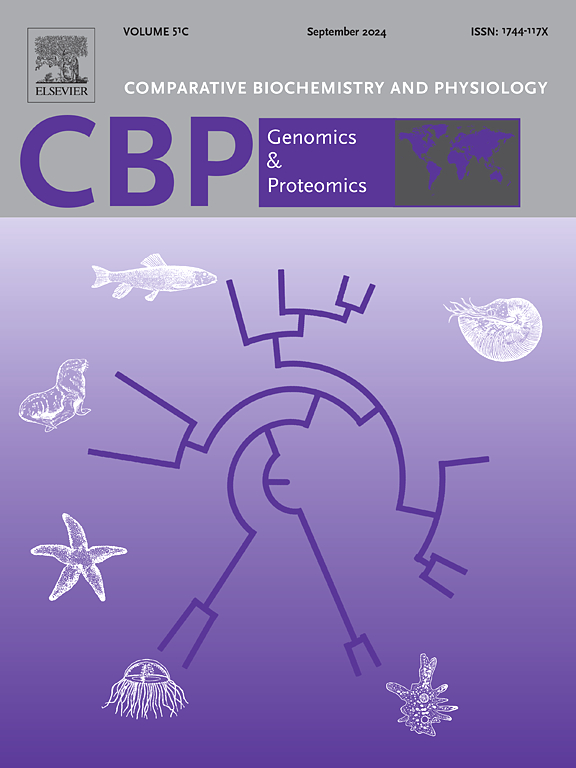Selection of heat-resistant strains in Bohai Red Scallops and their transcriptomic responses to heat stress
IF 2.2
2区 生物学
Q4 BIOCHEMISTRY & MOLECULAR BIOLOGY
Comparative Biochemistry and Physiology D-Genomics & Proteomics
Pub Date : 2025-05-22
DOI:10.1016/j.cbd.2025.101541
引用次数: 0
Abstract
Temperature has consistently been a critical environmental factor in the cultivation of scallops, and with global warming, marine animals will likely experience even more exposure to heat stress. Thus, it is necessary to select heat-resistant strains in scallops. In this study, heat stress selection was performed on the unselected Bohai Red scallop (CG) using the measured upper median lethal temperature (LT50), yielding an elite group (EG), from which the heat-resistant F1 offspring (EGF1) were reproduced. Tolerance to heat stress was significantly increased in EGF1, as evidenced by the elevated LT50 and the activities of certain antioxidant enzymes. Transcriptomic analyses and GO and KEGG analyses demonstrated that both EG and CG animals may mitigate heat stress and maintain cellular homeostasis through pathways associated with protein folding, energy metabolism, and antioxidant mechanisms. Furthermore, the scallops in the EG group showed a strong immune profile, with immune-related DEGs enriched mainly in interleukin-1 receptor binding and Toll-like receptor pathways. Conduct GO and KEGG enrichment analyses on the MM.darkolivegreen module, which demonstrates the strongest positive correlation with heat stress in Weighted Gene Co-expression Network Analysis (WGCNA). These analyses revealed pathways consistent with those identified in differentially expressed genes (DEGs), thereby providing mutual validation of the results. These results enhance our understanding of the molecular mechanisms driving heat stress adaptation in Bohai Red scallops and establish a theoretical foundation for the inheritance and evolution of heat-resistant traits.

渤海红扇贝耐热菌株的筛选及其对热胁迫的转录组反应
温度一直是扇贝养殖的一个关键环境因素,随着全球变暖,海洋动物可能会经历更多的热应激。因此,有必要对扇贝进行耐热菌株的筛选。本研究利用测得的上中位致死温度(LT50)对未选择的渤海红扇贝(CG)进行热胁迫选择,得到一个精英群体(EG),并从中获得耐热F1后代(EGF1)。EGF1对热胁迫的耐受性显著增加,这可以从LT50和某些抗氧化酶活性的升高中得到证明。转录组学分析以及GO和KEGG分析表明,EG和CG动物都可以通过与蛋白质折叠、能量代谢和抗氧化机制相关的途径减轻热应激并维持细胞稳态。此外,EG组扇贝表现出较强的免疫特征,免疫相关的DEGs主要富集于白细胞介素-1受体结合和toll样受体途径。对MM.darkolivegreen模块进行GO和KEGG富集分析,在加权基因共表达网络分析(Weighted Gene Co-expression Network Analysis, WGCNA)中发现该模块与热应激的正相关最强。这些分析揭示了与差异表达基因(DEGs)中鉴定的途径一致的途径,从而为结果提供了相互验证。这些结果有助于进一步了解渤海红扇贝热胁迫适应的分子机制,为耐热性状的遗传和进化奠定理论基础。
本文章由计算机程序翻译,如有差异,请以英文原文为准。
求助全文
约1分钟内获得全文
求助全文
来源期刊
CiteScore
5.10
自引率
3.30%
发文量
69
审稿时长
33 days
期刊介绍:
Comparative Biochemistry & Physiology (CBP) publishes papers in comparative, environmental and evolutionary physiology.
Part D: Genomics and Proteomics (CBPD), focuses on “omics” approaches to physiology, including comparative and functional genomics, metagenomics, transcriptomics, proteomics, metabolomics, and lipidomics. Most studies employ “omics” and/or system biology to test specific hypotheses about molecular and biochemical mechanisms underlying physiological responses to the environment. We encourage papers that address fundamental questions in comparative physiology and biochemistry rather than studies with a focus that is purely technical, methodological or descriptive in nature.

 求助内容:
求助内容: 应助结果提醒方式:
应助结果提醒方式:


